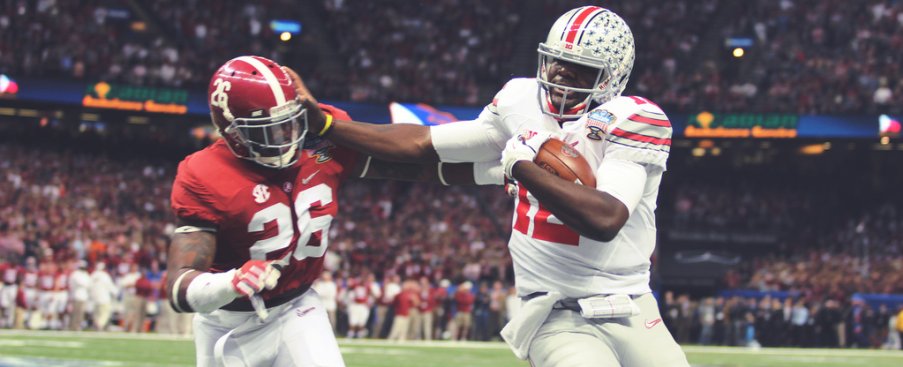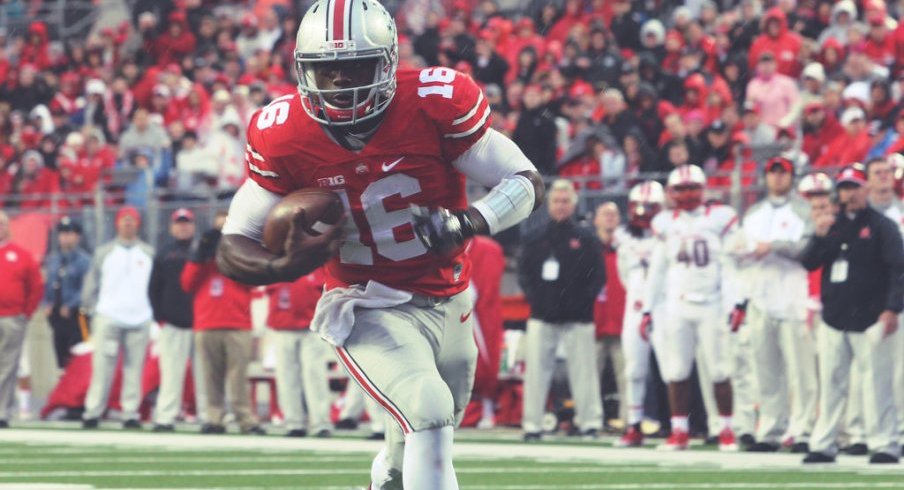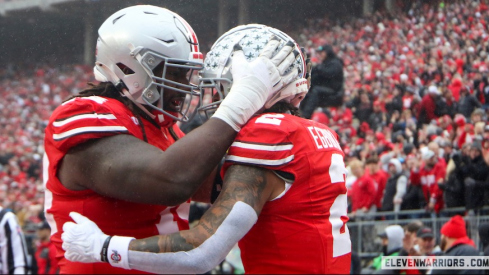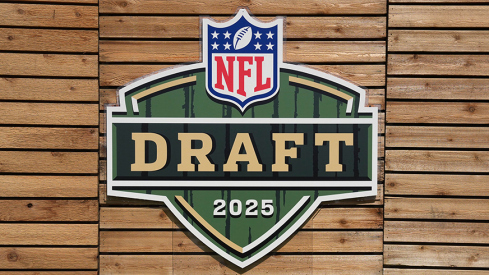Since way back in 2012 when Urban Meyer arrived at Ohio State and rode quarterback Braxton Miller to a perfect 12-0 record one narrative in Columbus has centered on Meyer's sometimes over-reliance on his signal-caller's legs, especially in tight games.
The narrative was of particular concern entering the 2016 season knowing Meyer's supreme trust in J.T. Barrett which could conceivably open him up to injury. That of course is of major significance knowing just how important Barrett is to the team, compounded by the relative inexperience of his backup, redshirt freshman Joe Burrow.
So exactly how has 2016 panned out with regard to Barrett's workload? And has Meyer repeated his pattern of leaning even more heavily on his quarterback to rush the football in tight games?
For answers to those questions I dug into the numbers each year dating back to Meyer's first season at the helm.
| QUARTERBACK | RUSH ATTEMPTS | RUSH YARDS | RUSH TD |
|---|---|---|---|
| B. MILLER | 227 | 1,271 | 13 |
| K. GUITON | 9 | 32 | 0 |
| COMBINED QB TOTALS | 236 | 1,303 | 13 |
| TEAM RUSH TOTALS | 559 | 2,907 | 37 |
| QB % OF TEAM TOTALS | 42% | 45% | 35% |
Forced to play without running back Carlos Hyde for a few games (and not yet knowing what kind of talent he was) and with Miller's passing skills dangerously raw, Meyer leaned on his quarterback's legs at a rate not seen since.
Miller rushed the ball at least 15 times in nine of 12 games for what would end up as the nation's 10-best rushing attack (242 rush ypg) and 46th-best total offense (423 ypg).
In games decided by seven points or less, Miller averaged 19 carries for roughly 85 yards with a high of 23 carries, reached three times in wins over Michigan State (23/136), Indiana (23/149) and Wisconsin (23/48).
What Meyer asked of Miller from a rushing standpoint wasn't much different in the six other games decided by eight points or more as he averaged 20 carries for about 132 yards.
Carrying the ball 227 times, or 41% of the team's carries to go along with 1,271 yards, or 44% of the team's output, Miller's season remains unmatched by any other Buckeye quarterbacks from the standpoint of Meyer riding his quarterback in the run game.
| QUARTERBACK | RUSH ATTEMPTS | RUSH YARDS | RUSH TD |
|---|---|---|---|
| B. MILLER | 171 | 1,068 | 12 |
| K. GUITON | 40 | 330 | 5 |
| C. JONES | 17 | 128 | 1 |
| COMBINED QB TOTALS | 228 | 1,526 | 18 |
| TEAM RUSH TOTALS | 635 | 4,321 | 45 |
| QB % OF TEAM TOTALS | 36% | 35% | 40% |
With a now-known quantity in Hyde at tailback, Meyer wasn't quite as reliant on his quarterback in the run game in 2013 as Miller tallied 171 rushing attempts in 14 games after logging those 227 carries in 12 games the year prior.
Miller still finished as the squad's 2nd-leading rusher with 1,068 yards as the Buckeyes ranked 5th in rushing offense and 7th in total offense.

Meyer's dependence on his quarterback in big games was virtually static to 2012 with Miller averaging 20 carries (versus 19 the year prior) for 103 yards in losses and/or games decided by seven points or less.
The Buckeyes went just 2-2 in said contests with wins over Wisconsin (31-24) and Michigan (42-41) and losses to Sparty (Give It To Hyde) and Clemson (40-35)
In Ohio State's 10 wins by eight points or more, Miller averaged just 13 carries (for 99 yards).
| QUARTERBACK | RUSH ATTEMPTS | RUSH YARDS | RUSH TD |
|---|---|---|---|
| J.T. BARRETT | 171 | 938 | 11 |
| C. JONES | 72 | 296 | 1 |
| COMBINED QB TOTALS | 243 | 1,234 | 12 |
| TEAM RUSH TOTALS | 690 | 3,967 | 41 |
| QB % OF TEAM TOTALS | 35% | 31% | 29% |
During the national championship season of 2014, Meyer's reliance on the quarterback run stayed virtually flat in comparison to 2013.
That might be surprising to some considering Ezekiel Elliott was an unknown quantity to start the year but found traction after the first month then absolutely exploded down the stretch theoretically creating less necessity for the quarterback to augment the rushing attack.
Interestingly though, Barrett logged 14.3 carries through 12 games before his ankle exploded and while his backup, Cardale Jones, wasn't known as a runner, he still ran it 17 times versus Alabama and 21 times versus Oregon after just eight totes in the undressing of Wisconsin in his first collegiate start. (I know not all of those were "runs" but play along.)
Combined, the duo of Barrett and Jones carried the ball at least 15 times in nine of 15 games for the nation's 9th-best rushing (264 ypg) and total offense (511 ypg).
In losses and/or games decided by seven points or less, Barrett/Jones averaged 20 carries for 94 yards. In Ohio State's 11 wins by eight or more points they averaged 15 carries for 88 yards.
| QUARTERBACK | RUSH ATTEMPTS | RUSH YARDS | RUSH TD |
|---|---|---|---|
| J.T. BARRETT | 115 | 682 | 11 |
| C. JONES | 64 | 193 | 2 |
| COMBINED QB TOTALS | 179 | 875 | 13 |
| TEAM RUSH TOTALS | 567 | 3,188 | 39 |
| QB % OF TEAM TOTALS | 32% | 27% | 33% |
Last year, with Meyer utilizing both Jones and Barrett under center for just over half the season before going to Barrett full-time while having the luxury of Zeke at tailback, Ohio State quarterbacks ran the ball just 32% of the time, good for an all-time low in the Meyer era.
Obviously, the low total was influenced by the notion Jones simply wasn't an electric runner as evidenced by him having no more than 13 carries in any game.
Meanwhile, even though he shared time for a good stretch of the season Barrett logged at least 15 carries on six occasions including the last four outings of the year after seizing the starting job and serving a one-game suspension.

What sticks out the most about the quarterback usage in 2015 is that in the three games decided by seven points or less –one played by the duo (UNI 5 for 29), one played by only Barrett (MSU 15 for 44) and one played by only Jones (IU 9 for -20) – they averaged only 10 carries for 18 yards, going 2-1 in the process.
Conversely, in Ohio State's games decided by eight points or more, OSU quarterbacks averaged 15 carries for 82 yards.
Opting to ride Elliott most of the time but struggling to cohesively distribute the ball to a plethora of weapons, Meyer's juggernaut ranked a disappointing 41st in total offense (434 ypg) despite featuring the nation's 11th-best rushing attack (245 ypg).
| QUARTERBACKS | RUSH ATTEMPTS | RUSH YARDS | RUSH TD |
|---|---|---|---|
| J.T. BARRETT | 194 | 847 | 9 |
| J. BURROW | 12 | 58 | 1 |
| COMBINED QB TOTALS | 206 | 905 | 10 |
| TEAM RUSH TOTALS | 560 | 3,100 | 33 |
| QB % OF TEAM TOTALS | 37% | 29% | 30% |
This season Meyer has reverted back to his old ways with OSU quarterbacks carrying the ball 37% of the time, good for the highest percentage since 2012's one-man offense.
The narrative has played out in kind with Barrett logging at least 15 carries in seven of 12 games so far while averaging 21 carries in Ohio State's five games decided by seven points or less, good or the highest mark of any signal-caller since Meyer's return to Columbus.
| YEAR | AVG ATT | AVG YDS | W-L |
|---|---|---|---|
| 2016 | 21 | 84 | 4-1 |
| 2015 | 10 | 18 | 2-1 |
| 2014 | 20 | 94 | 3-1 |
| 2013 | 19 | 103 | 2-2 |
| 2012 | 19 | 86 | 6-0 |
For comparison, in Ohio State's seven games decided by eight points or more, the quarterbacks are averaging only 14 carries.
Multiple factors are creating Barrett's heavy workload including his own talent, the reality of breaking in a redshirt freshman running back and a receiving corps that has Meyer relying on the run out of necessity.
The result is Ohio State boasting the nation's 9th-best rushing attack (258 ypg) but only the 76th-best passing attack (221 ypg) combining for the 21st-ranked total offense (479 ypg).
With Ohio State's date with Clemson in the College Football Playoff semifinal sitting just eight days away, it's hard to imagine Meyer deviating from what got him this far so expect a heavy dose of Barrett on the ground as the Buckeyes make a bid to play for their 2nd national title in three seasons.


